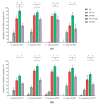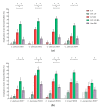Lactobacillus crispatus BC1 Biosurfactant Delivered by Hyalurosomes: An Advanced Strategy to Counteract Candida Biofilm
- PMID: 33401413
- PMCID: PMC7823809
- DOI: 10.3390/antibiotics10010033
Lactobacillus crispatus BC1 Biosurfactant Delivered by Hyalurosomes: An Advanced Strategy to Counteract Candida Biofilm
Abstract
The emergence of resistance to antifungal drugs has made the treatment of vulvovaginal candidiasis (VVC) very challenging. Among natural substances, biosurfactants (BS) produced by Lactobacillus have gained increasing interest in counteracting Candida infections for their proven anti-adhesive properties and safety profile. In the present study, liposomes (LP-BS) or liposomes coated with hyaluronic acid (HY-LP-BS) were prepared in the presence of the BS isolated from the vaginal strain Lactobacillus crispatus BC1 and characterized in terms of size, ζ potential, stability and mucoadhesion. The anti-biofilm activity of free BS, LP-BS and HY-LP-BS was investigated against different Candida albicans and non-albicans strains (C. glabrata, C. lusitaniae, C. tropicalis, C. krusei and C. parapsilosis), clinically isolated from patients affected by VVC. The inhibition of biofilm formation and the dispersal of pre-formed biofilm were evaluated. The obtained phospholipid vesicles showed suitable size for vaginal application and good stability over the storage period. HY-LP-BS exhibited good mucoadhesive properties and the best anti-biofilm profile, both in preventing or limiting the surface colonization by a broad spectrum of Candida species. In conclusion, the formulation of a novel antifungal agent derived from the vaginal microbiota into mucoadhesive nanocarriers appears to be a promising biotherapeutic strategy to counteract vulvovaginal candidiasis.
Keywords: Candida; Lactobacillus; biofilm; biosurfactant; hyalurosomes; liposomes; mucoadhesion.
Conflict of interest statement
The authors declare no conflict of interest.
Figures




Similar articles
-
Anti-Candida Activity of Hyaluronic Acid Combined with Lactobacillus crispatus Lyophilised Supernatant: A New Antifungal Strategy.Antibiotics (Basel). 2021 May 25;10(6):628. doi: 10.3390/antibiotics10060628. Antibiotics (Basel). 2021. PMID: 34070335 Free PMC article.
-
Biosurfactant from vaginal Lactobacillus crispatus BC1 as a promising agent to interfere with Candida adhesion.Microb Cell Fact. 2020 Jun 18;19(1):133. doi: 10.1186/s12934-020-01390-5. Microb Cell Fact. 2020. PMID: 32552788 Free PMC article.
-
Antifungal and Antivirulence Activity of Vaginal Lactobacillus Spp. Products against Candida Vaginal Isolates.Pathogens. 2019 Sep 12;8(3):150. doi: 10.3390/pathogens8030150. Pathogens. 2019. PMID: 31547398 Free PMC article.
-
Biofilms and vulvovaginal candidiasis.Colloids Surf B Biointerfaces. 2019 Feb 1;174:110-125. doi: 10.1016/j.colsurfb.2018.11.011. Epub 2018 Nov 7. Colloids Surf B Biointerfaces. 2019. PMID: 30447520 Review.
-
Non-albicans Candida spp. causing fungaemia: pathogenicity and antifungal resistance.J Hosp Infect. 2002 Apr;50(4):243-60. doi: 10.1053/jhin.2001.1151. J Hosp Infect. 2002. PMID: 12014897 Review.
Cited by
-
Vaginal Lactobacillus Impair Candida Dimorphic Switching and Biofilm Formation.Microorganisms. 2022 Oct 21;10(10):2091. doi: 10.3390/microorganisms10102091. Microorganisms. 2022. PMID: 36296367 Free PMC article.
-
Protective Mechanisms of Vaginal Lactobacilli against Sexually Transmitted Viral Infections.Int J Mol Sci. 2024 Aug 23;25(17):9168. doi: 10.3390/ijms25179168. Int J Mol Sci. 2024. PMID: 39273118 Free PMC article. Review.
-
Anti-Candida Activity of Hyaluronic Acid Combined with Lactobacillus crispatus Lyophilised Supernatant: A New Antifungal Strategy.Antibiotics (Basel). 2021 May 25;10(6):628. doi: 10.3390/antibiotics10060628. Antibiotics (Basel). 2021. PMID: 34070335 Free PMC article.
-
Inhibitory effect of lactobacilli supernatants on biofilm and filamentation of Candida albicans, Candida tropicalis, and Candida parapsilosis.Front Microbiol. 2023 Feb 13;14:1105949. doi: 10.3389/fmicb.2023.1105949. eCollection 2023. Front Microbiol. 2023. PMID: 36860488 Free PMC article.
-
Exopolysaccharides from vaginal lactobacilli modulate microbial biofilms.Microb Cell Fact. 2023 Mar 8;22(1):45. doi: 10.1186/s12934-023-02053-x. Microb Cell Fact. 2023. PMID: 36890519 Free PMC article.
References
-
- Dominguez E., Zarnowski R., Sanchez H., Covelli A.S., Westler W.M., Azadi P., Nett J., Mitchell A.P., Andes D.R. Conservation and Divergence in the Candida Species Biofilm Matrix Mannan-Glucan Complex Structure, Function, and Genetic Control. MBio. 2018;9:e00451-18. doi: 10.1128/mBio.00451-18. - DOI - PMC - PubMed
LinkOut - more resources
Full Text Sources
Other Literature Sources

